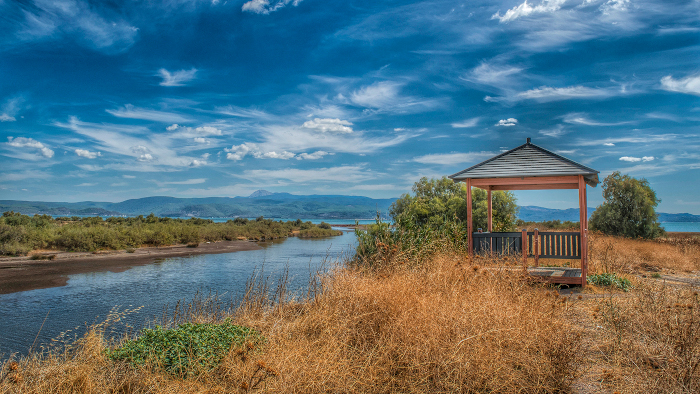On the eastern coast of the island, at the site Thermi, an extensive settlement of the early Bronze Age (3200 - 2000 BC) was investigated with islands of houses, craft and storage areas, perimeter roads and other elements of urban organization. The excavation has been reinforced. Only a few ceramic findings are known from the Mycenaean period on the island (13th - 12th centuries BC). Around 1100 BC they came from the Northern Peloponnese Aeolians and founded the first Aeolian colony, Mytilini. From there they later crossed over to the opposite coast of Asia Minor and founded a series of Aeolian cities in the area that became known as the "Mytilenean coast" or "Lesbian land". Around the middle of the 6th c. BC the federation (the "Koinon") of the Lesbians was founded, to which the five autonomous city-states of Mytilana, Pyrrha, Antissa, Eresos and Mithymna belonged. Lesvos flourished especially in Hellenistic times (3rd - 1st century BC). In 88 BC passed into Roman rule. Important figures of antiquity come from Lesvos, such as the poets Sappho, Alkaios and Krinagoras, the politician Pittakos and the philosopher Theophrastus.
The core of ancient Mytilene is located in the area of the Venetian Castle, which was separated from the opposite land by a narrow strait, the Euripos. Walls from the 4th century BC have been preserved. Inside the fortress that was built on the site of the ancient acropolis, 6th and 5th century BC buildings were discovered (perhaps the sanctuary of Demetrius and Koris). Remains of the two ancient ports are visible in the sea, at Fanari. Large Hellenistic and Roman houses with elaborate mosaic floors, ceramic workshops, parts of the wall and many tombs are revealed in the city. The theater, at the western end of the city, is very damaged (first phase from the 3rd century BC, mainly the Roman phase survives, around 55 BC), but it had impressive dimensions (seats for about 10,000 audience).
In a geometric arched building (second half of the 8th century BC) of ancient Antissa, the famous "Lesbian system" in the construction of walls appears for the first time, which was widely spread in many regions of the Greek world. Vaulted buildings, possibly sanctuaries, were also found at Mithymna and Pyrrha. Parts of archaic precincts with Lesbian masonry survive in Mithymna, Arisvi, the acropolis of Eresos ("Mastos") and elsewhere. Important sanctuaries were found in Klopedi (near Agia Paraskevi Kallonis) with remains of two archaic temples, perhaps dedicated to Napaian Apollo (mid 6th century BC, with Aeolian capitals in Napi) and in Mesa (arch. Messon), where it was the center of the federation (the "Koinos") of the Lesbians and Zeus was worshiped together with Hera and Dionysus (foundations and architectural members of an Ionic temple, late 4th - early 3rd century BC Ruins of a Doric temple in honor of Dionysus (1st century BC) were discovered at Cape Agios Fokas, Loda in ancient Vrissa. In the location of Arfikeia Lapsarna (region of ancient Antissa) tradition places the oracle of Orpheus, at the point where the sea had taken out his severed head. A well-preserved part of a Roman aqueduct with marble pessos (early 3rd century AD) can be visited outside the village of Moria, while another part of it is preserved near the village of Lambou Myloi. 55 early Christian basilicas have been identified in various parts of the island, mainly in coastal areas, on the borders of ancient cities and settlements. Mytilini: basilicas of Kastro, Dikastirio, Agios Polykarpos (identified by an inscription). Thermi area: Karies, Mistegna (two basilicas). South of Mytilene: basilicas in Kratigo and Argala. Gulf of Geras: basilicas of Loutra, Lakerdas, Plakados, Peramas, Skopelos. Many basilicas around the bay of Kalloni: basilicas of Achladeri, Meos, Gernas, Lisvori (two), Polychnitou (three), etc. Eressos: basilicas of Afendelli, Agios Andreas, Xokaotrou, etc. Sigri: basilicas of Xokaotrou, Paliokaotrou, Paliochorio, Stamata (Chapel of Panagia) and Megalonisio (island). Antissa: basilicas of Lapsarno, Gavvathas, Agios Archangelos, Kokkinos, Kefalos. Agia Paraskevi: basilicas of Agios Therapontos, Limonas and Taxiarchis. Basilica in Halinados and two basilicas near Skalochori (Tsukalochori). Northern Lesvos: basilicas of Ypsilometopou (remains of a monastic complex in the surrounding area), Agios Alexandros (SW of Lafiona), Petra (three), Agia Theoktistis (coastal location of Mnos, near Molyvos), Sykamia, Kleios, Anoktos, Sklavounas (between Komidados and Mandamou), Kavakli (south of Mandamados). The Archaeological Museum of Mytilene exhibits finds from all over the island. Archaeological Collections also exist in Mithymna and Eresos.
Editor: Fotini Anastasopoulou
